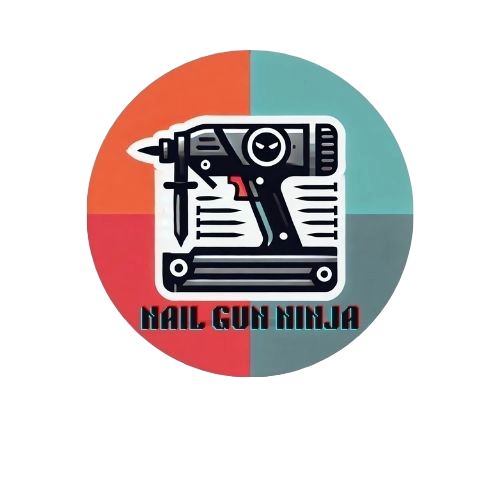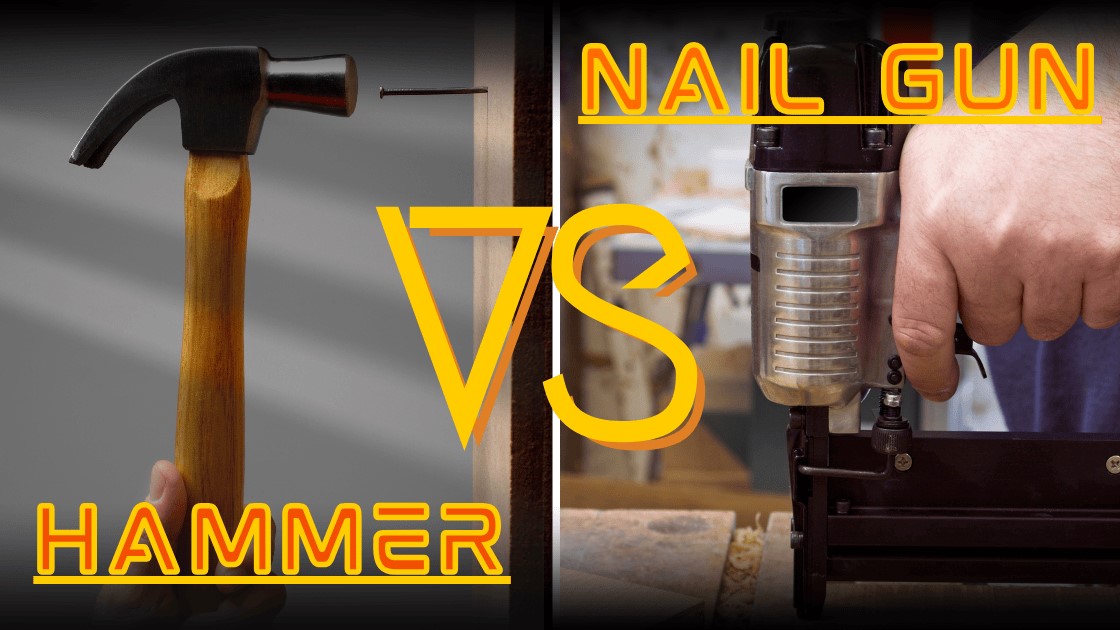When I was a beginner in this field, it was very confusing for me to decide which tool should I use – a Nail Gun or Hammer. I always thought that both of them were nail-driving tools, so which one would fit my project? So, I began to use a hammer first, because at that time I hardly knew about the use of nail guns.
But gradually when I learned about nail guns it became easier to choose which one would be right for me. It was a journey for me. If you want to know about my journey and every aspect of these two tools stay with me.
Regarding projects that require driving nails, two tools come to our mind: the nail gun and the hammer. Choosing between these two tools is often a matter of headache even if you are a professional. Beginners find it more confusing like me.
Nail guns offer speed and efficiency, while hammers give control and simplicity. Each has its strengths and limitations, and the right choice depends largely on your project, skill level, and personal preference.
Nail Gun: Features and Benefits

Nail guns are ideal for powerful and efficient operations. They save time and labor. Nail guns use electric, pneumatic, or battery power to drive nails. These tools significantly reduce manual effort compared to traditional methods. These can handle high-volume tasks like framing, roofing, or decking. Also, nail guns are consistent and offer a professional finish.
These days, there is a nail gun for every task, from brad nailers for delicate projects to framing nailers for high-volume tasks. Many nail gun models are lightweight which decreases arm fatigue. Although nail guns save our time and energy like no other method of driving nails does.
Different Types of Nail Guns
There are quite a lot of nail gun types that are being widely used in different kinds of projects. Let’s cover some of them:
Framing Nail Gun
Framing nail guns are designed for heavy-duty tasks. They are ideal for large projects like framing walls, building decks, and roofing. They use large nails.
Brad Nail Gun
18 gauge Brad nailers drive smaller, thinner Brad nails. These are perfect for delicate projects like trim work, molding, and cabinetry. These leave smaller almost undetectable holes.
Finish Nail Gun
Finish nail guns use slightly thicker nails than Brad nail guns. These are suitable for tasks like door and window trim, crown molding, and furniture assembly. Finish nail guns offer strong hold but still leave a clean finish.
Roofing Nail Gun
Roofing nail guns are specialized for roofing materials like fastening shingles, underlayment, etc. These can drive short nails at a rapid pace.
Flooring Nail Gun
Flooring nail guns are used to install hardwood floors. These can drive nails to secure the flooring planks without damaging their surface.
Pin Nail Gun
Pin nail guns are amazing for very fine detail work because they use ultra-thin pin nails. These nails leave very small holes. Pin nail guns are best for attaching small trim pieces or delicate moldings.
Staple Gun
Staple guns often fall under the nail gun category although technically they are a different type. These are also called upholstery nail guns. These are good for projects that require staples instead of nails.
Palm Nail Gun
Palm nail guns fit into the palm of your hand because they are compact and lightweight. These nail guns are often used for tasks like framing in tight or awkward spaces.
Cordless Nail Gun
Cordless nail guns are powered by a rechargeable battery. So they are portable. Cordless nail guns are versatile and come in various models, such as brad, finish, and framing nail guns. These are suitable for both indoor and outdoor projects.
Electric Nail Gun
Electric nail guns are plug-in nail guns. They offer consistent power and are often lighter than a few other nail guns. Although they lack the power of pneumatic nail guns, they are amazing for smaller DIY tasks.
There are a few other nail guns, such as nail guns for concrete and steel, coil siding nail guns, clipped-head framing nail guns, etc. If you want to know more about them, comment below!
Pros and Cons of Nail Guns
Pros
Increased Productivity
Nail guns significantly reduce the time and effort required for nailing. The faster pace of nail guns decreases the time any project would consume. So, in the case of large-scale projects, nail guns offer much-enhanced productivity.
Precise and Professional Result
Nail guns can place nails on the material more consistently than other methods. They create clean and polished finishes.
Less Physical Strain
Nail guns reduce the manual effort that is needed for repetitive nailing. As a result, they make nailing easier on wrists and arms.
High Versatility
Nail guns come in specialized models for different tasks like brad nailing, framing, roofing, etc. So the versatility of these is near to infinite!
Increased Power
Nail guns easily drive into hard materials like hardwood and composites. Its power has no comparison to the power of any other method of nail driving.
Time Efficiency
Nail guns drive nails at a rapid pace, making it less time-consuming than other methods. They are best if you are looking to complete projects quickly.
Cons
Expensive Initial Investment
Nail guns, especially high-quality models, are much more costly than traditional hammers. So these can be called an expensive addition to your collection.
Maintenance and Repairs
Nail guns require regular maintenance. It includes replacing parts like nails, fuel cartridges, or batteries.
Dependency on Power Sources
There are a few nail guns that need power sources while working. Like pneumatic nail guns require compressors, cordless nail guns rely on battery power.
Bulky and Less Portable
Nail guns can be tough to transport because of their bulky body and weight. They can also be less convenient to work with in small spaces.
Nail Gun Uses
Nail guns are of many uses. Let’s discuss a few uses of nail guns here:
Framing Projects
In the case of building walls, framing houses, and constructing decks, speed and precision are crucial. Nail guns can help a lot in these circumstances. Nail guns offer fast speed and consistent depth of nails. So these are very helpful in projects that need speed and precision.
Roofing Applications
Driving nails into shingles and underlayment is very energy-consuming. Nail guns efficiently drive nails into shingles or underlayment. So the physical labor gets reduced.
Also using a nail gun makes these works less time-consuming because of their fast pace.
Fencing Installation
Installing fences requires repetitive board attachments. Nail guns can attach a large amount of boards in a short amount of time. So installing fences using a nail gun is much more productive.
Flooring Installation
Hardwood planks are made of hard materials. Driving nails into hard materials has always been difficult for even professional woodworkers. Nail guns can secure hardwood planks accurately.
Also, they are perfect for flooring installation because they can drive nails into the material without damaging its surface.
Trim and Molding Work
Trim and molding works require utmost precision because otherwise the furniture piece may get damaged and the cost behind it might go in vain. Nail guns provide a clean and polished finish without splitting delicate materials.
So you don’t need to worry when you are using a nail gun to attach trim and moldings to your fragile or expensive furniture pieces.
Furniture Building
Cabinetry or wooden furniture needs strong, hidden fasteners otherwise they might disassembled. Nail guns attach these fasteners so well that they rarely break or disassemble.
Hammer Overview: Features and Benefits
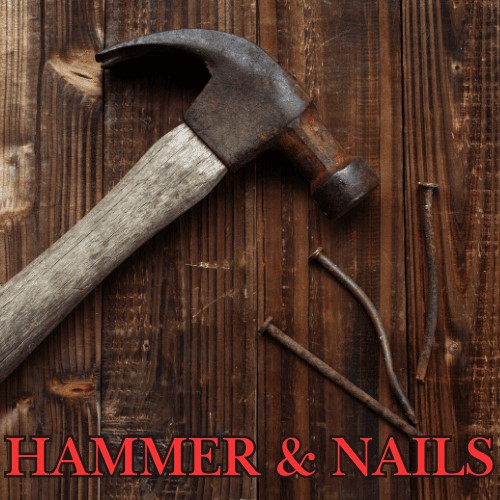
A hammer is a simple but versatile tool. It is a multi-purpose hand tool used for driving nails, demolition, reshaping objects, and more. It is a staple item in every toolbox. There is a wide range of hammers for every type of project.
Hammers are cost-effective which makes them more affordable than nail guns. Hammers are widely available. You can get one from your nearby tool shop. Hammers do not require any power source like compressors or batteries, they are more accessible to everyone because they are fully manual.
Hammers offer you great control over force and nail placement. It is good for delicate work like tapping small nails or assembling furniture. Hammers can be used in any environment including, cold and remote areas.
They are durable because they are made with steel and wood. Hammers require minimal maintenance and last for years. They are easy to carry and very convenient.
Types of Hammers
There are various types of hammers. A few are discussed below:
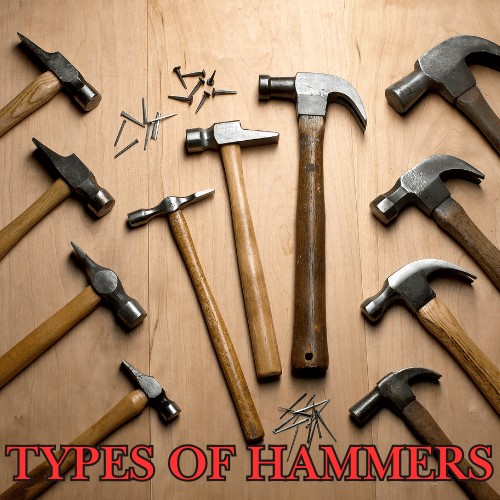
Claw Hammer
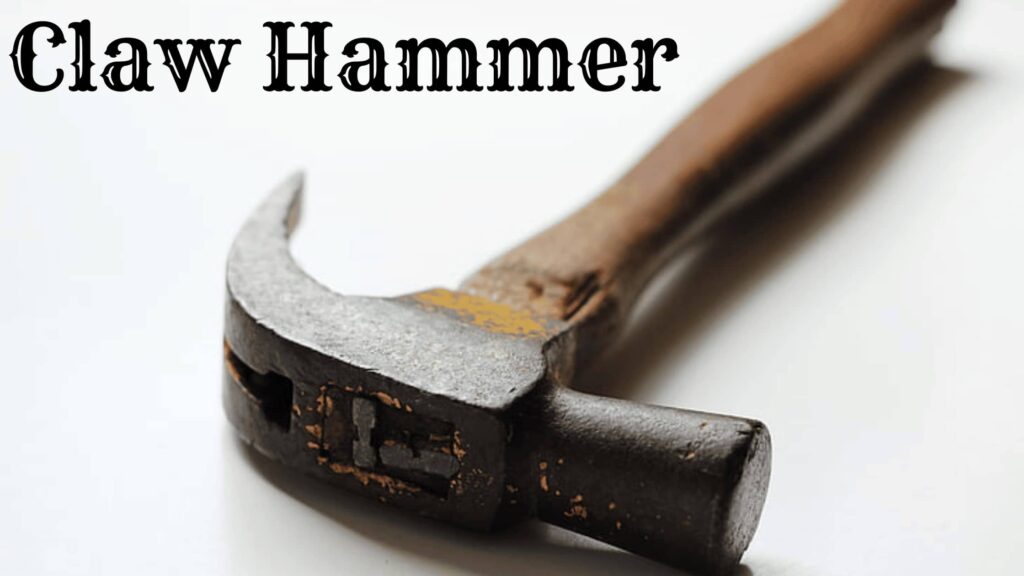
This is the most common of all types of hammers. It has two ends. One end is for driving nails and the clawed one is for removing them. It is versatile and can be used for many DIY and construction projects.
Ball-Peen Hammer
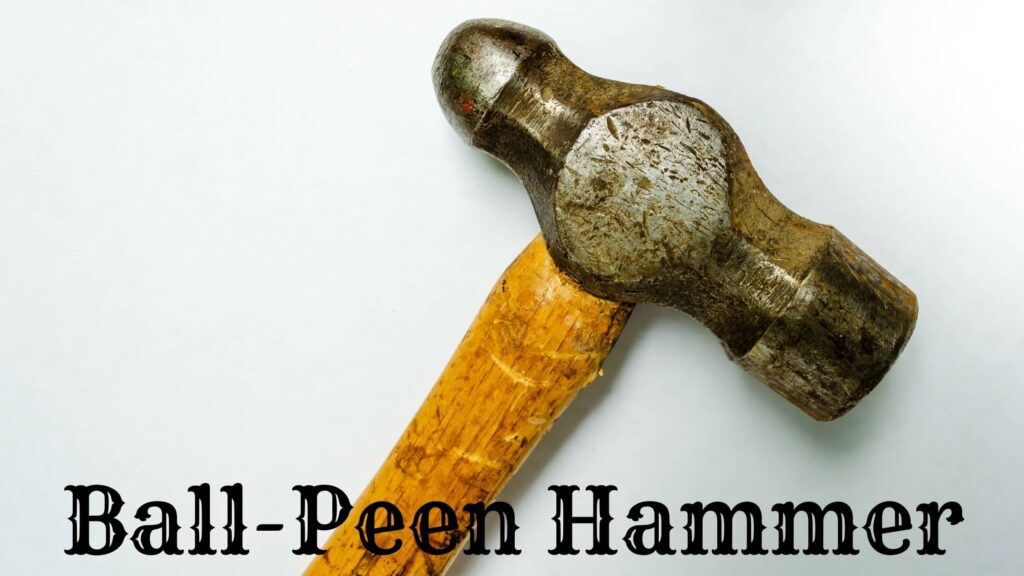
This hammer has a flat striking face and a rounded, ball-like peen. The flat striking face is used for metalworking and the ball-like peen is for shaping metal. It’s mostly used in mechanics and metal fabrication.
Sledgehammer
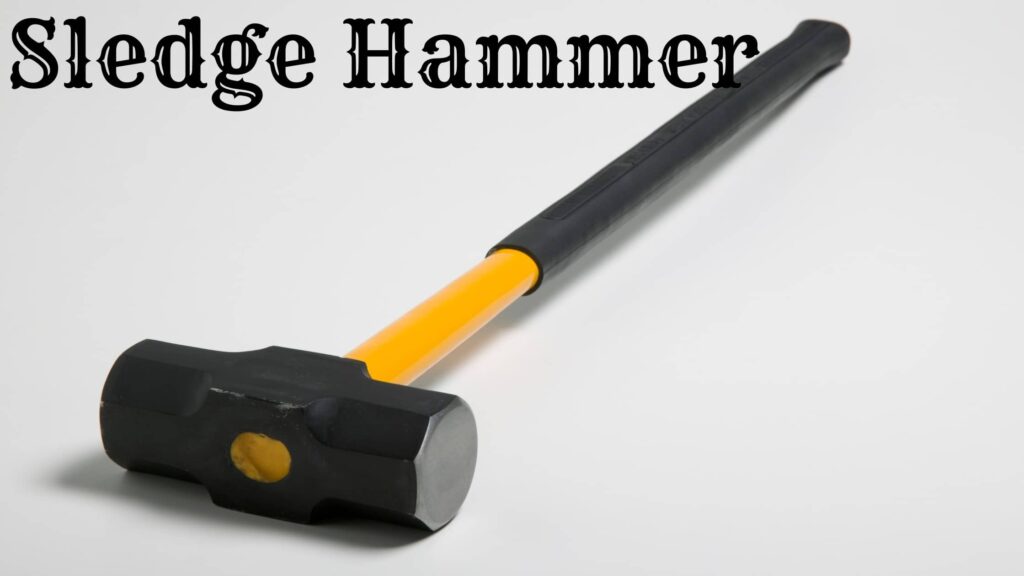
A sledgehammer has a large, heavy head. It is designed for heavy-duty tasks like demolition, breaking up concrete, or driving stakes into the ground. It requires both hands for effective use.
Framing Hammer
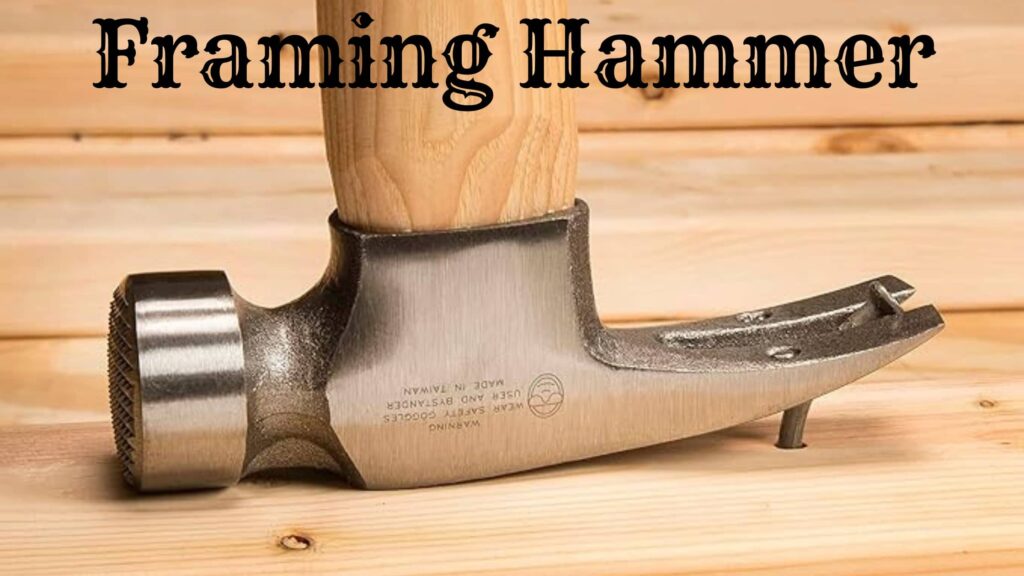
This hammer has a longer handle and heavier head than a claw hammer. So it can provide the power needed for framing and larger construction projects. Also, its face is milled which prevents slipping when driving nails.
Rubber Mallet
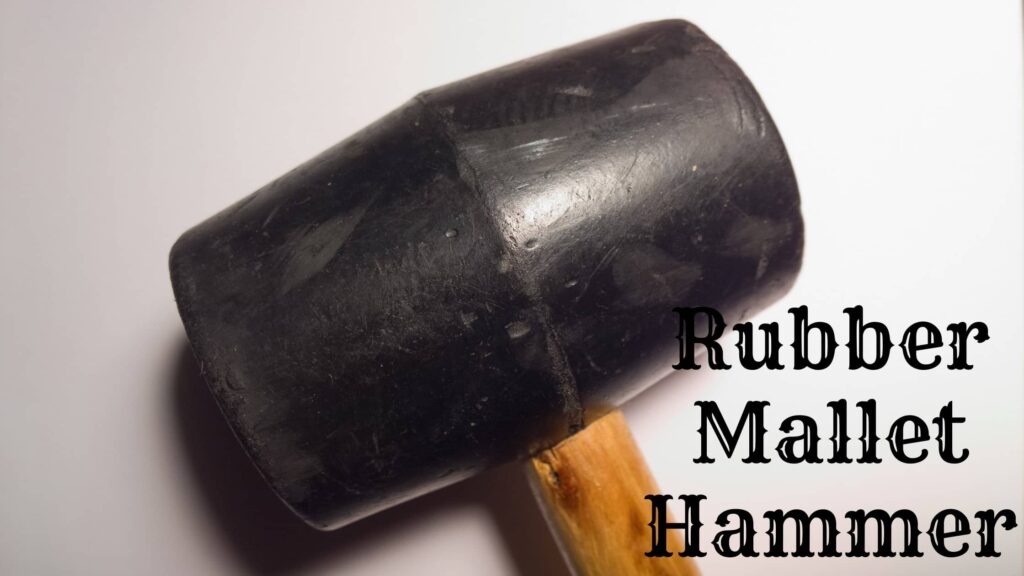
This hammer has a soft rubber head. It is ideal for delicate tasks where a standard hammer could damage the material. A rubber mallet is suitable for projects like setting tiles, assembling expensive furniture, or aligning wood joints.
Tack hammer
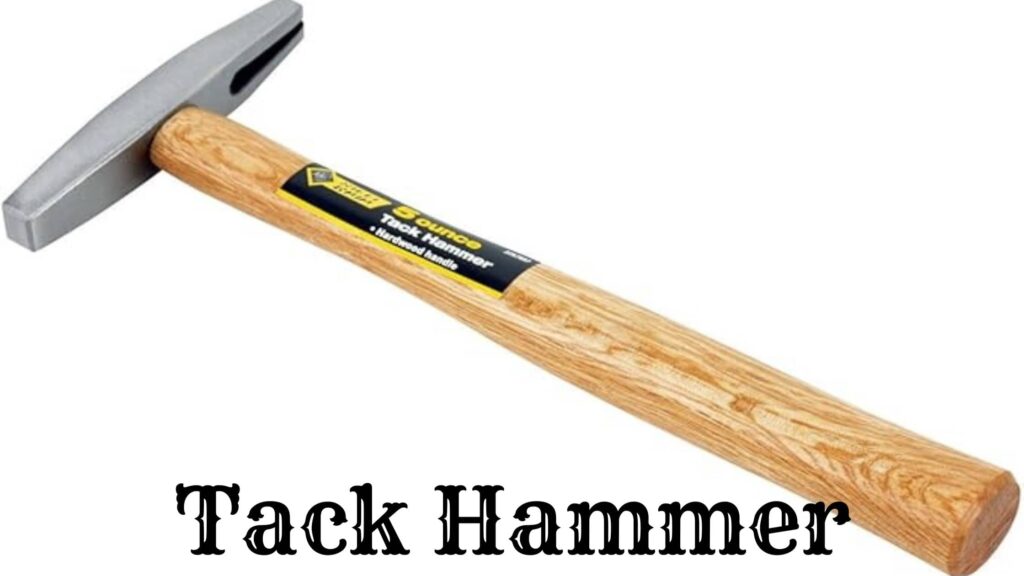
A tack hammer is also known as an upholstery hammer. It is lightweight and is used for driving tacks or small nails in upholstery works. It often has a magnetic face to hold small nails or tacks in place.
Dead Blow Hammer
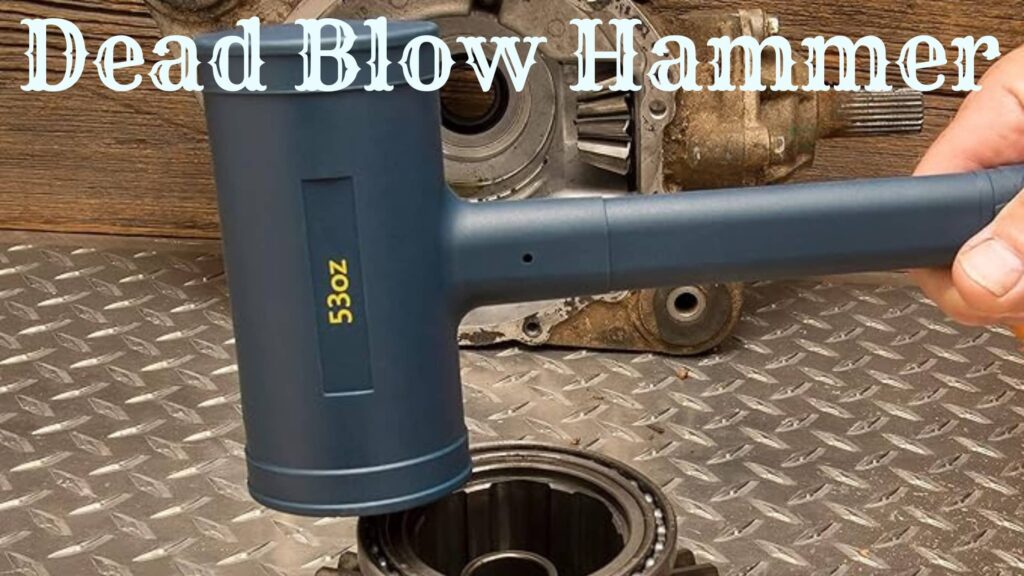
This hammer is filled with sand or metal shots. It is designed to minimize recoil. A dead blow hammer is useful when you want controlled impact without bouncing back. It is good for automotive work or metal shaping.
Tinner’s Hammer
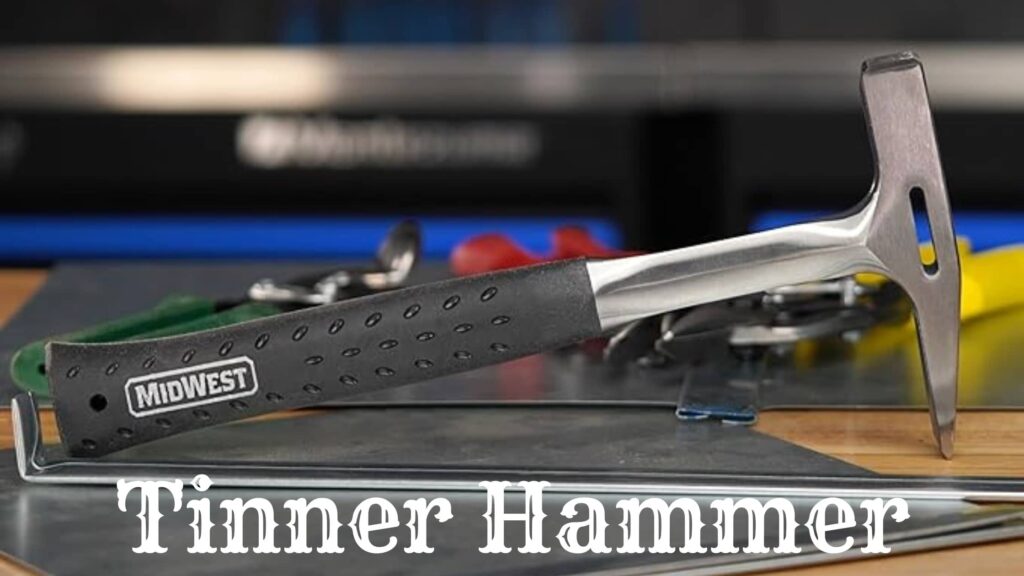
It is also known as a sheet metal hammer. A tinner’s hammer is used in metalworking to shape, smooth, and form sheet metal. It has a square flat face and a pointed peen and it is ideal for working with thin metal sheets.
There are other hammers such as brass hammers, electrician’s hammers, joiner’s mallets, croon-peen hammers, etc. Comment below if you’d like to know more about different kinds of hammers.
Pros and Cons of Hammers
Pros
Affordable and accessible
Hammers are budget-friendly. So if you are starting in woodworking, it will not be an expensive addition. Hammers are available in a range of prices to suit any budget.
Versatile for multiple tasks
Hammers can be used for a lot more tasks beyond just driving nails. They can be used for pulling nails, demolition, and shaping materials. So it is a versatile option for nail driving and will add versatility to your toolbox.
No Power Requirements
Hammers are fully manual. They are only used by hands. That is why hammers can be used anywhere. If you are working in a remote place where electric power or air compressors are not available, you can use a hammer for your projects.
Precise Force Application
As a hammer is used by one’s own hands and is not powered by electricity or air compressors, it offers more control than nail guns. It is more convenient to control pressure or striking angle when using a hammer. So it is ideal for delicate or detail-oriented tasks.
Minimal Maintenance Needs
Hammers are low-maintenance tools and last for a prolonged period of time. They rarely need any maintenance or parts changing. These characteristics make them less hectic to maintain.
Compact and lightweight
Hammers are smaller in size than most nail guns. Also, they are lightweight. Hammers can be easily carried from one place to another for their compactness and lightweightness. Also, you can use a hammer in a tight space where nail guns cannot be taken.
Cons
Time-Consuming
Large projects often require repetitive tasks. In this case, using a hammer can take a longer amount of time. A hammer is slower compared to a nail gun and makes the projects more time-consuming than a nail gun would do.
Physically Demanding
Hammers are fully manual. One uses his/her hand to drive nails through a hammer. Repetitive striking can cause fatigue or physical stress. Using a hammer can be very stressful for one’s health if they are working on a larger project.
Inconsistent Results
A hammer may not always offer consistency in nail depth and nail spacing. Without proper practice, nails may not be driven straight into the material and leave an uneven surface. This would result in a less clean finish and also can damage expensive furniture pieces.
Limited Efficiency on tough materials
Hammers may drive nails into softer woods or materials easily. But they are not always the best for driving nails into harder materials. Hammers often struggle with dense woods. Dense woods require higher force and hammers have a limited amount of force for it being manual.
Potential for User Error
If the striker is not well-skilled, the striking angle or striking force on the nails may not be perfect. This will cause bending nails or damaging materials.
Uses of Hammers
The hammer is of great use. A few of the uses are discussed below:
Small-Scale Repairs
Small household tasks like fixing loose nails or assembling simple furniture do not require much speed or force. So in these circumstances, a hammer is of great use. Without any electric power or compressor power, your household errands will be looked into.
Pulling Nails
We often run into improperly driven or old nails that look ugly and cause discomfort. Also when nails are not properly driven, they make expensive pieces look cheap. Claw hammers are great for removing them!
Demolition Tasks
One fine morning you decided to renovate your pantry space into a walk-in closet! But that requires demolishing drywall and you’ve got no clue how to do that. Hammers would be your best help in this case. Hammers are great for breaking apart drywall, concrete, or wooden structures during renovations and repairs.
Driving Stakes or Anchors
Ground-level installations like securing tent stakes or fixing gardening things can be hard without proper tools. A hammer can help you do these without much worrying.
Shaping and Bending
Shaping and bending materials need high power and great control. So hammers are useful in metalworking for bending or reshaping softer metals.
Precision Tapping
If you need to drive some small nails but a nail gun is not helping much you should try a hammer. Hammers are good at driving small nails as they have more precision. Also, hammers are great for working with delicate materials because they offer control over the power one is using.
General DIY Projects
If you want to hang a picture on your living room wall or assemble the new shelf, you better choose a hammer. Light construction works are better done with a hammer than splurging on expensive nail guns.
3 Real-Life Projects Where Hammers Outperforms Nail Guns
Removing Nails or Demolition Work
The claw side of a claw hammer is indispensable when it comes to pulling out nails from any material. Again, hammers provide leverage and control during demolition tasks like tearing out old cabinets, removing wooden flooring, or dismantling furniture.
They greatly help extract nails or break apart materials without damaging surrounding structures. On the other hand, nail guns are solely designed for driving nails. They lack the versatility of pulling nails out or breaking any material.
Assembling Delicate Furniture or Crafts
Projects like assembling wooden picture frames, crafting handmade furniture, or repairing musical instruments require working with small or fragile elements. A hammer offers the slow, deliberate action needed for these tasks. Even a low-powered nail gun splits softwood or thin wood pieces.
So a hammer gives you the ability to drive nails gently. It ensures the security of the material and also maintains a high level of craftsmanship.
Working in Spaces Without Power or Compressed Air
Nail guns are power Tools. They require power, whether it be air, gas, or electricity. But in places where power tools are impractical, such as remote locations, outdoor settings, or areas without access to electricity, a hammer always shines.
In the case of off-grid construction projects like building a small shed in the woods or repairing fencing on a farm, hammers are reliable because they don’t depend on external energy sources.
Detailed Comparison of Nail Guns & Hammers
Power Source and Operation
Nail guns need pneumatic, air, gas, or electric power to work. With these power sources, they can drive nails with ease and speed. Hammers are, on the other hand, manual. Hammers are powered by manual force. They rely on physical strength and control.
Speed and Efficiency
Which one is better for speed and efficiency – nail gun or hammer? Nail guns have a fast pace. So they can do repetitive work faster than hammers. Also for their faster pace, nail guns can complete tasks in less time than hammers. So nail guns are efficient for larger projects. Though hammers are slower, they offer precision. So they are more suitable for detailed and smaller work.
Noise and Vibration
Nail guns, especially pneumatic nail guns can be very loud. Their noise often exceeds 90 decibels and using them requires hearing protection. Hammers are quieter than nail guns though they still produce a notable amount of sound when struck on harder surfaces like concrete. However, many nail guns generate significant vibration, which can lead to discomfort. On the other hand, hammers cause less vibration but stress out the wrist during repetitive tasks.
Accuracy and Precision
Hammers offer unlimited precision for delicate tasks. They allow users to drive nails with control over depth and angle. The great control that hammers allow their users to have, is very helpful to work in accurate measures. Nail guns are faster but they can sometimes misfire or drive nails too deep and this is not ideal for woodworking or trim work. Many nail guns feature adjustable depth settings, which improves their accuracy. But still, it takes a lot of experience to drive nails accurately through a nail gun.
Cost and Maintenance
Nail guns have a higher initial cost. It is an expensive addition to your tool collection. Also, they require regular maintenance like lubrication, parts replacement, etc. Hammers are affordable and more accessible. You can buy one from your nearby tool shop. Again, hammers rarely require maintenance. So it is an easy tool to start with and DIYers and professionals find it easily accessible.
Portability and Accessibility
Cordless nail guns offer significant portability. But most of the nail guns are bulkier including the cordless nail guns. So being bulky makes them tough to transport. Also, nail guns need additional equipment. On the other hand, hammers are lightweight, compact, and easy to carry. Hammers fit into nearly every toolbox and do not require any additional equipment.
Impact on Project Quality
Nail guns offer consistent driving depth. They ensure that all nails are ser uniformly which is important for a professional finish. Cabinetry, flooring, etc tasks require this kind of finish. Hammers provide manual control. Sometimes the user does not have enough ability to drive nails properly through a hammer. So they can leave variations in nail depth and it can harm the final appearance of the piece.
Versatility and Application Range
Nail guns are of various types. Each type has a variety of models. Each specializes in a specific type of work like framing, roofing, and upholstery. So nail guns are excellent for professional applications but limit their versatility. Hammers are excellently versatile with a range of types, from claw hammers to mallets. This variety allows hammers to be usable across a variety of projects from metalwork to demolition.
Which Tool is More Beginner Friendly?
Hammers are simple tools and this characteristic makes them ideal for beginners. Because beginners often struggle with the technicalities of nail gun operation. Also, nail guns require safety training to avoid misfires or injuries, while hammers have a lower amount of risks to start with.
Many models of nail guns cost a hand and a leg. But hammers are affordable. Their affordability makes them suitable for beginners who are experimenting.
The main thing that decides which one is better to use, is the scale of the projects. For small tasks, hammers are sufficient. But for the larger tasks that require speed, a nail gun is needed to consume less time and energy.
Again, nail guns can be a headache to maintain as they demand regular lubrication, parts changing, etc. But hammers need no maintenance and run for years.
Finally, Beginners may find hammers easy to master, whereas nail guns require longer training for the user to learn to work with them. So decide wisely!
Which One is Greener or More Eco-Friendly?
Nail guns consume energy from air, gas, or electric sources. But hammers only require manual force to operate. They are made from durable materials like steel and they often last decades with minimal maintenance. So hammers make less waste than nail guns.
The batteries used in the cordless nail guns eventually need replacing. Those replaced batteries add to the electric waste if not recycled properly. Hammers have no batteries so there is no chance for them to contribute to electric waste.
Nail guns have an intensive production process and require mechanical components to make. On the other hand, the hammer-making process is simple. There are nail guns that are gas-powered. They emit greenhouse gases during operation. But hammers make no emissions.
Should I Own Both or Not?
If you are planning to work on a wide range of projects, owning both the nail gun and hammer would provide you versatility. By owning both you can easily handle smaller tasks to larger scale projects. Hammers are essential for detail work, demolition, and manual adjustments, while nail guns are good with high-volume, repetitive tasks.
Nail guns are an expensive investment, but they save time, especially in larger projects and repetitive tasks. Hammers are affordable and simple and are great for DIY projects. Learning a hammer is easy while working with nail guns needs training and safety measures. Hammers are comparatively safer.
Owning both a hammer and nail gun ensures you always have a reliable backup. If your nail gun malfunctions, you can use the hammer to complete the task. Also owning both tools gives you the possibility to work on diverse projects. They save you money and money in the long run.
Hammer vs Nail Gun – At a Glance
| Attributes | Nail Gun | Hammer |
| Primary Use | Fast and efficient nail-driving for larger projects | Precision nailing, demolition, and smaller projects |
| Common Types | Framing, Brad, Finish, Roofing, Flooring, Pin | Claw, Sledge, Ball-Peen, Rubber Mallet, Framing |
| Power Source | Pneumatic(air), Battery, Electric, Gas-Powered | Manual (muscle-powered) |
| Speed | Fast, especially for repetitive tasks | Slower, reliant on the user’s speed and strength |
| Precision | Moderate precision, and high speed for bulk tasks | High precision, suitable for delicate tasks |
| Portability | Depending on type, cordless options are highly portable | Hammers are not portable. Users use their hands and muscle power. |
| Weight | Typically heavier due to motor or battery | Lightweight to medium |
| Maintenance | Requires regular cleaning, lubrication, and parts check | Low maintenance |
| Safety Requirements | High, goggles, ear protection, and gloves recommended | Low, safety goggles recommended |
| Cost | Higher initial cost | Lower cost, affordable options available |
| Noise Level | High, Especially pneumatic models | Generally low, higher with sled and framing hammers |
| Types of Fasteners | Nails(varied types based on models) | Nails, stakes, chisels(for specialized types) |
| Ideal Projects | Framing, roofing, flooring, cabinetry, molding | Woodworking, metalwork, demolition, assembly |
| Ergonomics | Cordless and palm nailers are easier on the hands | Lighter hammers are ergonomically easier to handle |
| Best for Beginners | Brad or finish nail gun for easier control | Claw or rubber mallet for versatility |
| Suitability for Tight Spaces | Palm nailers or cordless options | Claw and small hammers fit in compact areas |
| Special Skills Required | Safety training, handling technique | Minimal, basic hammering skills sufficient |
| Control Over Power/Force | Varies, limited control over depth and force | Full control over force applied |
| Adaptability to Materials | Works on wood, masonry (with concrete models), and metal (specialized nail guns) | Adaptable, works on wood, metal, and other materials with specialized hammers |
Which One to Choose for My Next Project?
A nail gun is typically the best choice for larger projects like framing, roofing, or flooring because it has a fast pace and the ability to handle high-volume work. On the other hand, a hammer is suitable for smaller tasks like trim work, furniture assembly, or repairs.
Again, beginners may find hammers to be easier to handle because they offer full control over the force applied and do not require extensive training. But, even after being efficient, using a nail gun needs experience due to its speed and less controllable force.
Nail guns can be used on various surfaces like wood, concrete (with specific models), and metal. Hammers are also adaptable overall and can work on multiple materials but with specialized types, like ball-peen hammers for metal or sledgehammers for demolition.
Using a hammer can be physically demanding but driving nails using a nail gun requires much less physical labor. So fatigue should be a topic to consider before deciding between the two tools.
One more important fact is that investing in nail guns can be costly, especially high-end models. But hammers are more budget-friendly and offer a wider range of affordable options for users at any skill level.
Nail guns, more or less, are tough to carry, whereas hammers are much easier to carry and can be carried anywhere in the world, may it be a remote area in Antarctica or a tight little corner of your garage. But taking a nail gun to a hard-to-reach space is gruesome.
Whichever tool you choose, always ensure safety while using it. If you are using any nail gun for your project follow nail gun safety tips properly. Also, stay safe while using a hammer. Always keep your finger in a safe position while hammering screws or nails.
Finally, I will suggest you consider the type, size, and frequency of your projects before deciding which one is the best for you. Hope the decision process has become easier for you through this detailed article.
FAQs
1. What is the main difference between a nail gun and a hammer?
The primary difference between a nail gun and a hammer lies in operation and efficiency. A nail gun is a power tool that uses compressed air, electricity, or batteries to drive nails quickly and precisely. It is ideal for repetitive tasks. A hammer, on the other hand, is a manual tool that requires physical effort to drive nails and is suitable for smaller projects.
2. Which is better for beginners?
For beginners, a hammer is often the better choice because it’s simple, lower cost, and has minimal safety risks. However, if the project has large-scale or repetitive nailing tasks, a nail would be the best choice.
3. Are nail guns safe to use?
Yes, nail guns are safe when used correctly and with proper precautions. Most nail guns come with safety features to prevent accidental discharge. Wearing safety goggles and following the manufacturer’s instructions further minimizes risks.
4. Can a nail gun replace a hammer completely?
Not entirely. A nail gun is excellent for larger projects but a hammer is indispensable for tasks like pulling nails, precision work, or small household repairs. Both tools serve distinct purposes and complement each other.
5. How do I maintain my nail gun for long-term use?
Regular maintenance is essential for optimal performance. Clean the nail gun after each use, lubricate moving parts with pneumatic oil (for air-powered models), and check for worn or damaged components. Always store it in a dry, safe place to prevent rust or damage.
6. What are the advantages of using a hammer over a nail gun?
Hammers are affordable, portable, and versatile. They do not require power sources or regular maintenance. As a result, they are ideal for smaller tasks or environments where power tools are impractical.
7. What safety gear should I use when working with a nail gun?
Essential safety gear includes:
- Safety goggles to protect your eyes from flying debris.
- Ear protection if using loud pneumatic nail guns.
- Gloves for a secure grip and protection.
- Steel-toed boots to shield your feet from falling tools or materials.
8. What are the common mistakes to avoid when using a hammer?
You have to stop using the wrong hammer. Do some research and use the right hammer for your specific type of project. Hold the handle near the end for better leverage. While using a hammer, you should aim for straight and consistent strikes otherwise the nails can bend.
